When the same old paperwork and manual operations eat up about 40 percent of the time spent by your healthcare staff, it is a marker that something needs to change.
You know the drill — processes like patient data collection, onboarding, prescribing, and billing dominate a healthcare organization’s daily operations. While essential, these tasks are efficiency drainers that return less for the effort you put in.
The growth in poorly designed digital health records and healthcare metrics has required that physicians spend more and more time on tasks that don’t directly benefit patients, contributing to a growing epidemic of physician burnout.
Ashish Jha, Veterans Administration physician and professor, Harvard Chan School.
But things have changed for the good.
Thanks to technology, you can now automate the same healthcare workflows that rob your staff of their precious time and energy.
For this reason and more, tools that offer workflow automation in healthcare are gaining their deserved popularity.
In this article, we’ll see how you can use the same tools to iron out the wrinkles in your operational efficiency and, by doing so, help grow your healthcare enterprise the way you envision it.
What Does Healthcare Workflow Automation Mean?
As we touched on earlier, it’s the use of technology to automate and streamline the countless workflows your organization manages daily — which includes everything from scheduling appointments to managing patient records, staff rosters, activities, billing, healthcare insurance, and more.
In a nutshell, the aim is to automate the repetitive — to get things done faster, with less effort and even fewer errors otherwise incurred from manual processes.
Why Automating Healthcare Workflows Matter
The benefits of automation in healthcare are manifold. Let’s have a quick look at some of them.
1. Better accuracy
In healthcare, even a small mistake can lead to dire consequences. Patient data entered manually always bears the risk of human error, which not only endangers lives but also costs the healthcare industry an estimated $40 billion annually. Automation eliminates this risk by ensuring data is uploaded accurately, leaving no room for errors.
2. Easier patient interactions
Proper communication between healthcare providers and patients drives better outcomes. Automation helps ensure this is done by offering patients timely, reliable updates.
Take appointment no-shows, for instance. Many patients miss appointments simply because they forget. By sending automated reminders ahead of time, you can reduce no-shows, hence saving both time and money lost from missed medical appointments.
3. Cost savings
Automation improves a healthcare organization’s operational efficiency in ways that traditional methods can’t match, directly contributing to cost reduction.
- By reducing the risk of medical errors, automation helps avoid expensive legal fees, insurance claims, and costly corrections.
- Streamlining repetitive tasks like scheduling, billing, and patient onboarding eliminates the need for overtime and administrative burden, cutting operational costs.
- It ensures that staff time and resources are allocated better, thereby improving productivity and cutting down unnecessary expenses.
To sum up, cost savings result from the broad capabilities of workflow automation in healthcare.
4. Hassle-free data management
Patient data in healthcare is vital for delivering proper care. However, retrieving this data becomes tougher if stored physically and manually. With automation, you can manage and analyze large amounts of data on the go, which can then inform healthcare professionals in their decision-making by offering them valuable insights. Moreover, you can access the data instantly whenever it’s needed.
5. Safety and compliance
Workflow automation strengthens both security and compliance. By handling tasks like data management, it reduces human errors that can lead to breaches. Every action is logged automatically, ensuring compliance with regulations in healthcare like HIPAA. Built-in security features and alert options in automation tools help prevent unauthorized access. In essence, automation protects sensitive data and keeps you on the right side of regulatory requirements.
6. Patient satisfaction
Everything adds to patient satisfaction — be it shorter wait times, simple onboarding, or a smooth patient discharge. Keeping such processes quick and straightforward is essential to keep patients happy. With workflow automation, you can improve patient experience in this regard. For instance, implementing automation to collect feedback will provide faster insights into what patients liked or disliked about the care delivered. An automated scheduling system allows patients to book an appointment quickly. Moreover, tracking patient appointment cancellations and confirmations reduces hospital wait time. Similarly, you can implement multiple workflow automation solutions to improve patient satisfaction.
7. More returns from your marketing campaigns
Automation helps you make the most of your marketing efforts by giving you deep insights into patient behaviors and preferences through real-time reports. With this data, you can craft campaigns that deliver the right message to the right audience at the right time. Automated tracking and analytics also let you measure which campaigns are driving the best results. This means you can focus on what works, refine what doesn’t, and make smarter, data-driven decisions to improve ROI.
8. Patient retention
It is now easier to stay in touch with your patients and keep them engaged, thanks to automation. For instance, you can use date-based triggers to send reminders for recurring events like annual health checkups. This ensures patients don’t forget about their appointments in their busy lives. Also, even small gestures like automated birthday wishes, can strengthen your relationship with the patient. So, through consistent communication with automation, you improve the chances of them returning to your practice for future treatments.
Top 7 Workflows in Healthcare to Automate
Without further ado, here are 7 examples of workflow automation in healthcare that your healthcare organization could benefit from.
1. Appointment scheduling process
68% of patients say they are more likely to choose a healthcare provider with better online access to book, modify, or cancel appointments.
An online appointment booking system can help you automate the process. There are several ways to implement this;
- You can start by having the option to book an appointment on your website.
- Installing chatbots can also help patients with the basic queries they may have before making any decision.
- Nowadays, healthcare organizations are also spending money on developing separate patient portals to execute processes ranging from appointment booking to consultation.
Benefits of automation in the appointment scheduling process:
With online portals, patients can book appointments themselves. They need zero staff assistance, which saves both of their time. Adding on, having multiple sources to book appointments also increases patient intake — meaning, an increase in revenue.
Below is a workflow automation example you can use.
2. Patient admission and discharge process
The process of admitting or discharging a patient can be lengthy and frustrating, both for the patient and the healthcare provider, since the processes involve a lot of paperwork. So, collecting information through manual forms before a consultation costs you your precious time, which can then cause long wait times for other patients in queue.
- 1 in 5 patients change doctors because of long wait times.
- 84% of people say that wait time is either “very important” or “somewhat important” in their overall experience.
- 43% of patients say waiting time is the most frustrating part of visiting the doctor.
- 30% of patients have walked out of an appointment because of long waiting times.
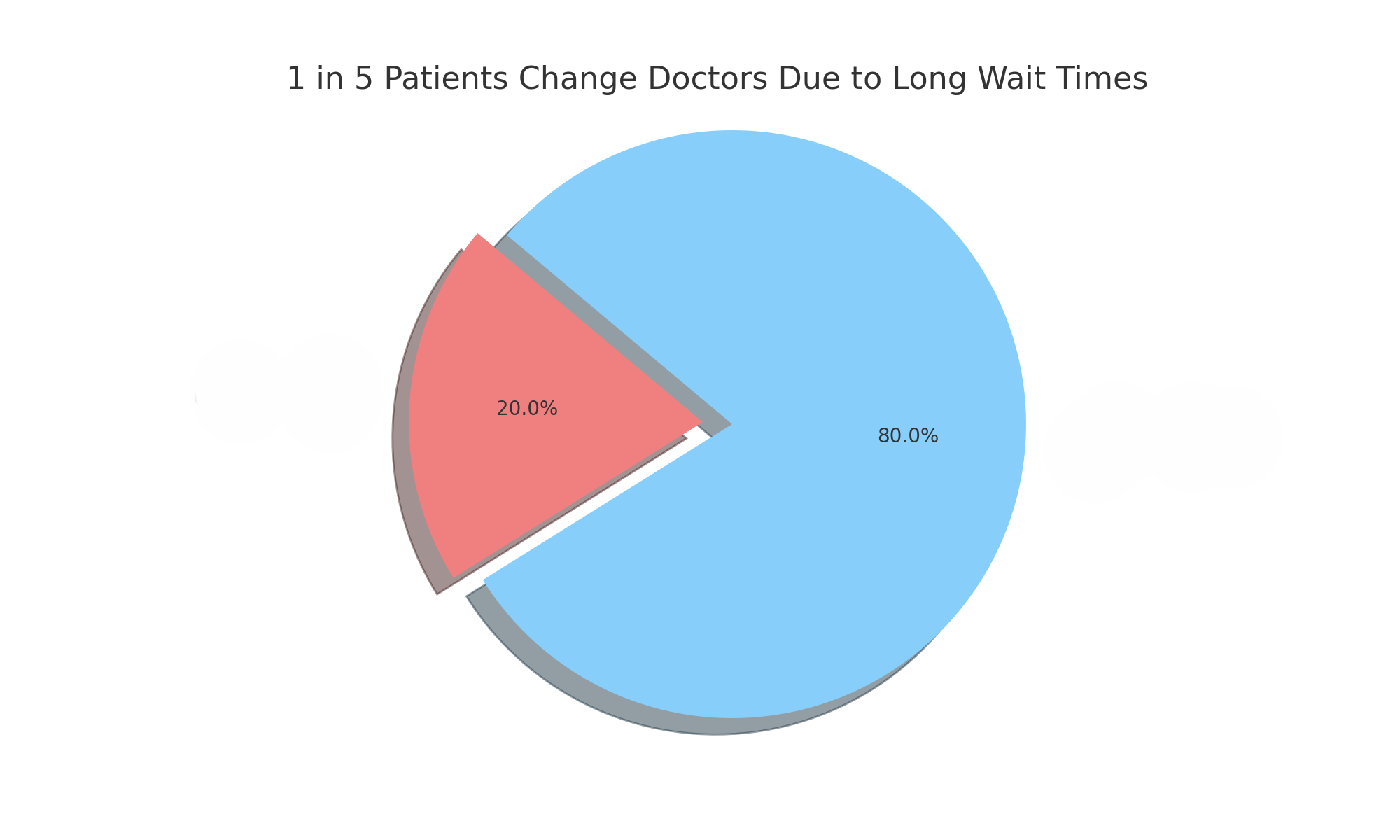
Doctors and staff also spend a lot of time collecting information. Since they do it manually and have no records for the next appointment, the same process gets repeated.
At the same time, discharge billing is a time-consuming task in itself. The longer the patient stays at your facility, the more time the billing process will take. Studies also say that 41% of patients are not confident that their billed amount would be correct because the manual discharge process is prone to human errors.
Approvals also increase discharge time, as the processes involved get entangled between multiple departments.
However, with functions like e-signature capabilities that come with automation, patient admission and discharge processes can be accelerated.
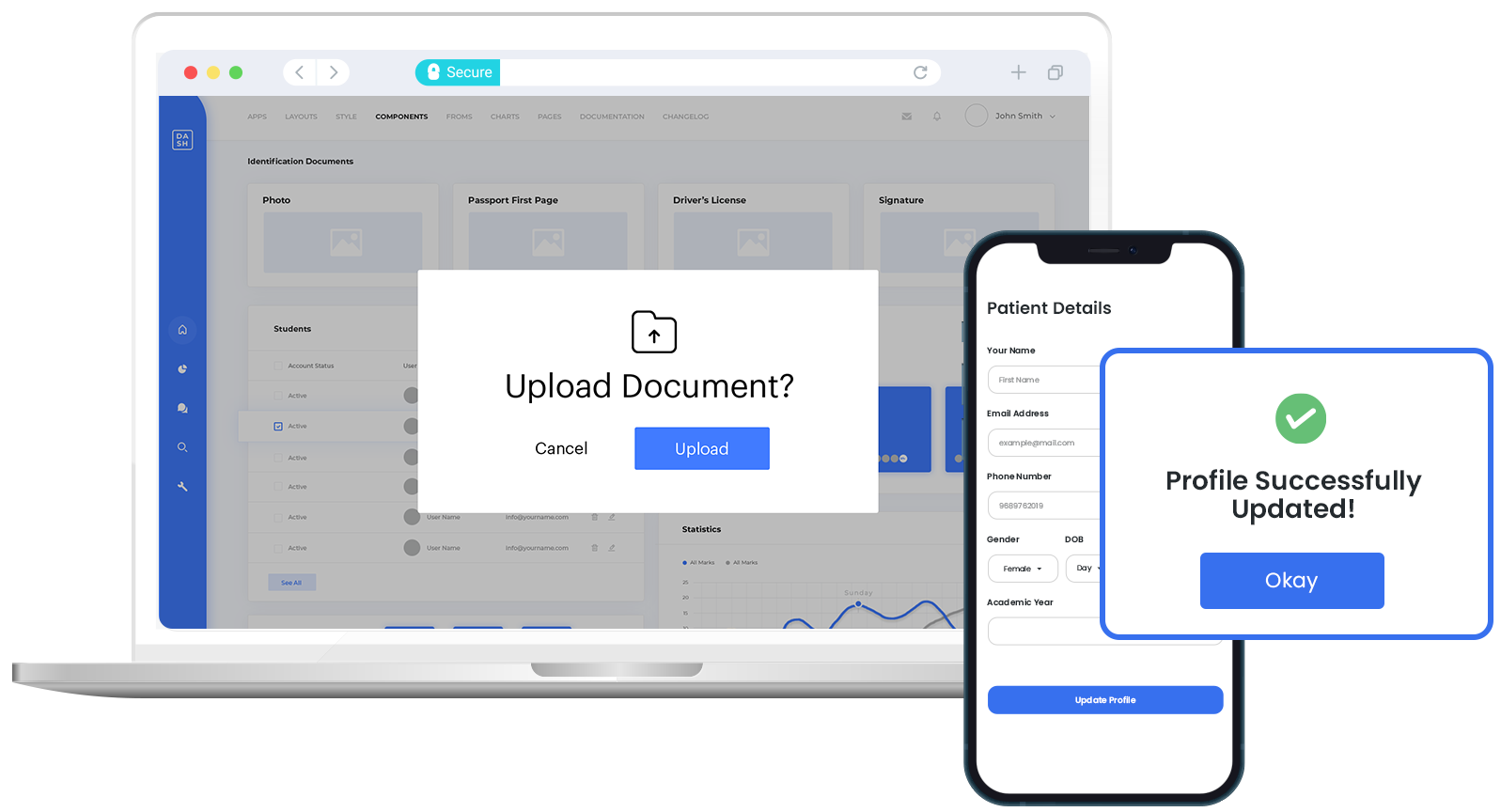
Benefits of automating patient admission and discharge process :
An efficient admission and discharge process is key to improving patient experience. Automation will save your staff from the manual work of filling out forms, creating bills, and getting approvals while reducing the chances of errors.
3. Managing health records
As we discussed earlier, the risk of errors is undeniable when healthcare providers manually enter important information into their electronic health records (EHR). A small error while entering data can lead to mistakes in the patient’s diagnosis. In worst-case scenarios, it can lead to the patient getting the wrong treatment.
Along with an EHR, a healthcare organization’s workflow might benefit from automation. For instance, there is no potential for errors if your hospital automates the procedure across medical test labs and integrates the EHR platform. You can automatically transfer lab reports and other information into an EHR using automation software. This aids doctors in accurately diagnosing patients’ conditions and prescribing the right course of treatment.
Benefits of letting automation handle patient health records:
Automating health record management hence reduces human errors. So you don’t have to think twice about potential mistakes as you take care of your patients.
4. Patient communication
70% of patients say they prefer medical providers who send them emails or text messages. This could be for preventive or follow-up care and other reminders.
Patients communicate with their healthcare provider at many stages of their healthcare journey. You can automate these interactions by installing bots to answer booking queries and help them secure appointments. You can also integrate the automation system with your IVR to resolve general questions while only passing the more nuanced ones to your staff.
Along with that, you can also automate reminders for upcoming appointments and for taking medications post-consultations. Automation can also help you improve patient engagement with using call reminders, email automation, and SMS to share self-care tips and treatment options.
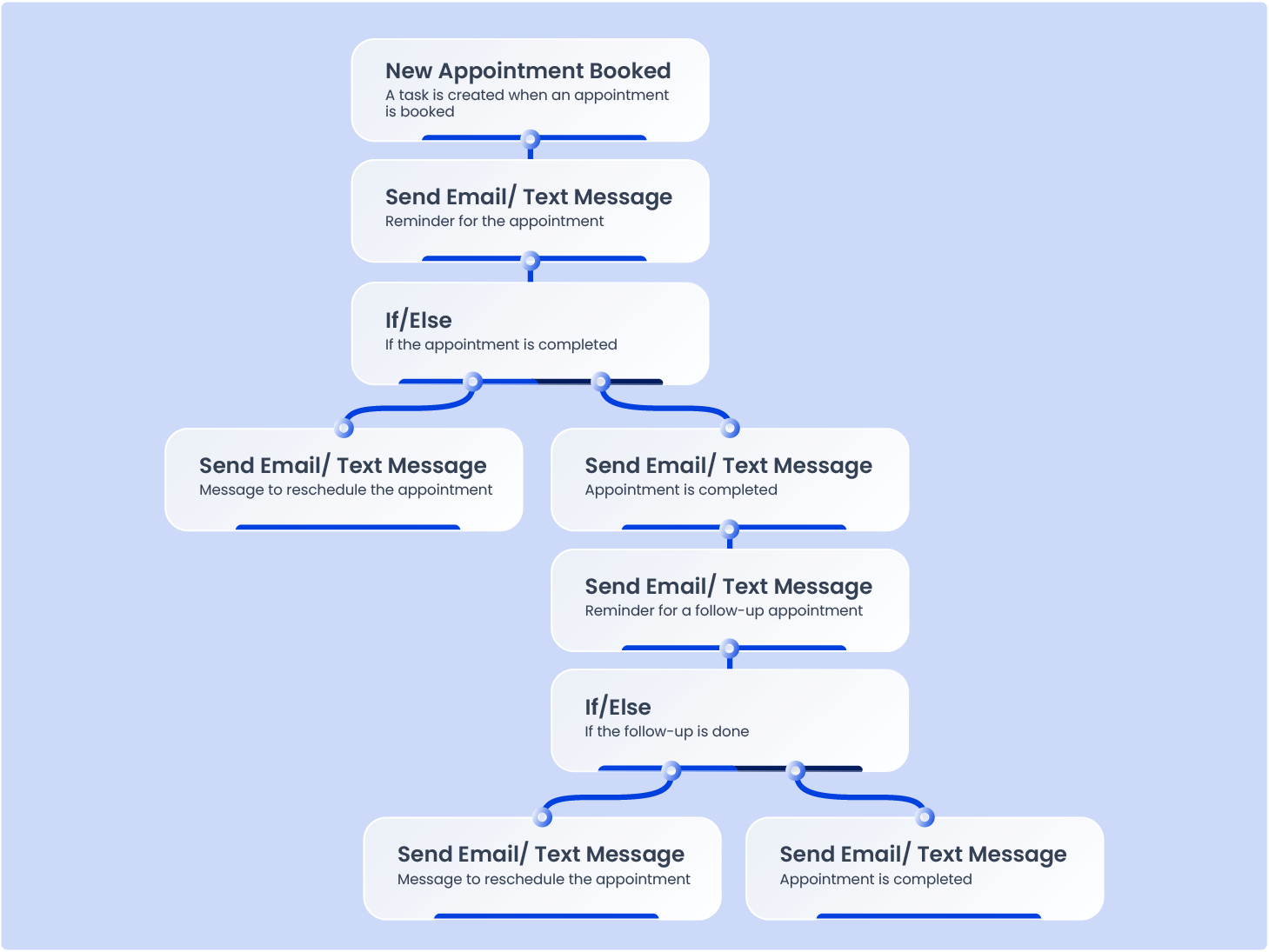
Benefits of automating patient communication:
Automating communication can reduce dependency on the staff and help resolve inquiries faster. Regular interaction also improves patient engagement by 2X. Of course, it also saves your staff more time.
5. Staff and doctor onboarding
Hiring the right staff is challenging for most healthcare organizations. Also, once hired, you would like your staff to start as soon as possible. Instead, they end up spending their initial days filling out multiple forms and submitting various documents.
Introducing an online portal for your staff onboarding can save you time and improve efficiency. You can automate the document collection process and also store records digitally.
Similarly, your doctor’s onboarding process can also be automated to save them from the tedious form-filling process.
Benefits of automating the staff onboarding process:
Automating the process reduces onboarding time. Since you will have the documents stored digitally, your staff or doctors will not have to share them again and again. Having an automated onboarding process also improves the overall experience of the staff and doctors.
6. Managing staff activities and roster
The Healthcare industry runs 24/7 to ensure patients get the proper care. The staff works in shifts, and managing their activity and roster is an add-on task for the organization. The process can often be disrupted or delayed due to even a single person’s non-availability.
There are many cloud applications available that can help you automate your employees’ schedules. They can also help you get approvals for your schedules and notify staff immediately.
You can also automate the distribution of tasks based on the roster. For example, automation will automatically distribute inquiries only to operational staff.
Benefits of automating staff activities and roster:
You can inform your staff about their schedule without confusion. You can reduce response time on inquiries through automation to improve overall team efficiency.
7. Insurance claim processes
Healthcare organizations claim billions in insurance every year. The process requires collecting a large amount of information from patients and healthcare providers. Handling repetitive tasks, such as collecting patient data and managing claims, manually takes a lot of time and increases the chances of human errors.
You can automate the insurance claim process using RPA tools. The tool will collect and arrange all the data to file your claim.
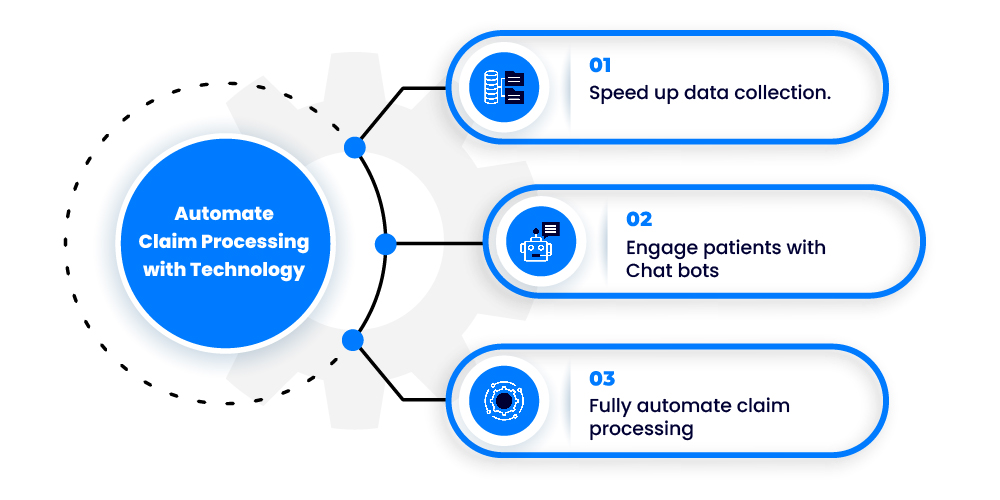
Benefits of automating insurance claim processes:
Automating insurance claim processes can increase efficiency and save up to 70% of process handling time. You can also mitigate any chance of human error and save from any financial loss.
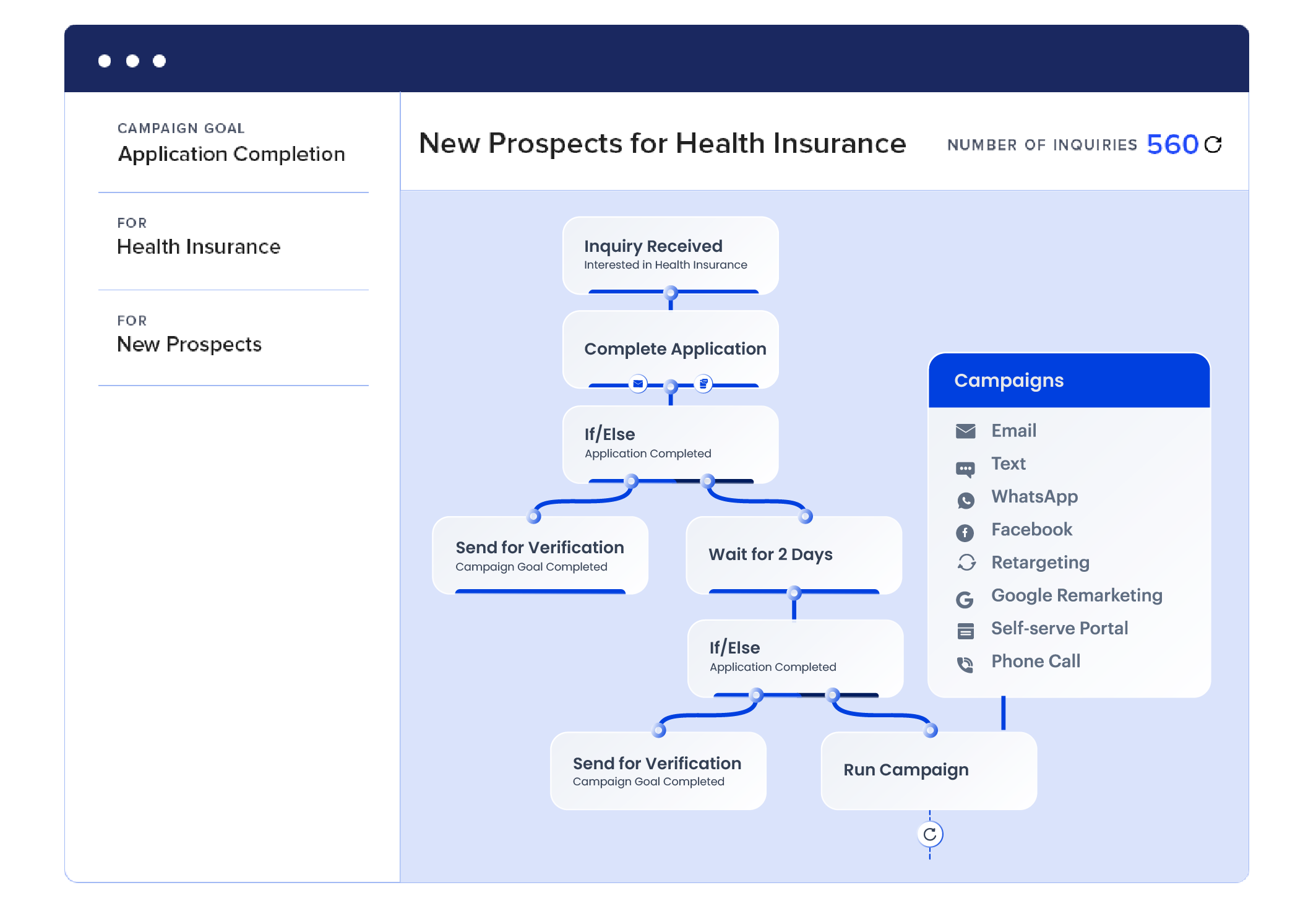
Use LeadSquared to Automate Healthcare Workflows
Workflow automation helps healthcare enterprises automate patient intake, communication with them, and many other workflows.
Implementing LeadSquared’s HIPAA-compliant healthcare CRM helps you improve:
1. Patient inquiry management
You can assign tasks and notify your staff about new patient inquiries. Enable your teams to call, email, and message patients with LeadSquared’s healthcare CRM while complying with HIPAA guidelines.
The CRM also helps you create multiple journeys and workflows for teams and functions like physician onboarding, sales, marketing, and operations.
2. Patient intake automation
Increase patient intake by automatically capturing their inquiries and distributing them to the correct department for follow-ups. Collect records through digital intake forms and self-serve patient portals to simplify the intake process.
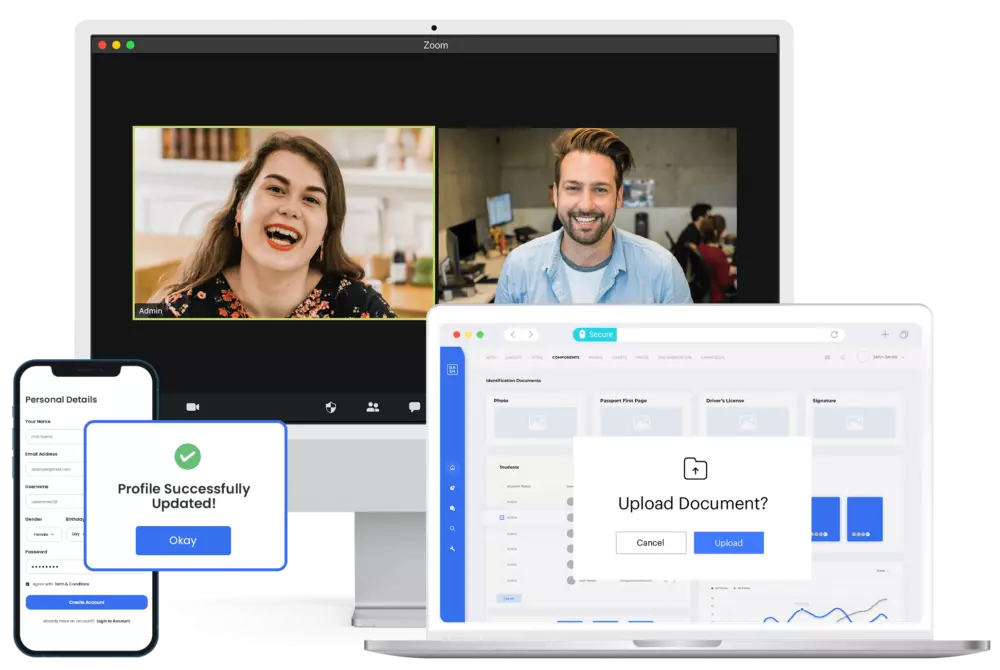
3. Communications management
Utilize LeadSquared’s healthcare CRM platform to use autoresponders for web inquiries and built-in dialers.
Real Stories, Real Results: How Healthcare Teams Benefited from Our Automation
Don’t just take our word for it. Hear it from the people who’ve been there, struggling with age-old methods and legacy systems — that is before automation came in offering them a helping hand out of the endless manual grind.
2x the patient volume, without the hassle
“Before, we could not get in contact with over 30% of patient leads. That number has reduced to under 5% now. We’re now handling over 2x the number than we did before automation existed.”
Bree Castillo, Chief Operating Officer at Tandem Care
Tandem Care, a non-medical home care provider, sends small teams of 2-3 caregivers to help clients with their daily living needs across neighborhoods. As they grew, their old CRM system became a problem. It lacked efficiency in automation, reporting, and customization, and they needed something HIPAA-compliant to manage health records.
That’s when they switched to LeadSquared. The platform addressed their key needs, helping them streamline their operations. With LeadSquared in place, their processes turned smoother, and caregivers became better equipped to do their jobs.
More customers, smoother sales
“We could not have scaled the way we did without LeadSquared’s automation. We were able to connect with more customers, streamline our sales, even improve our support and fulfillment processes. LeadSquared turned things around!”
Adi Mordechai, CTO and Co-Founder at Wesper
Before adopting LeadSquared, Wesper relied on spreadsheets to manage customer data and other processes. While this worked in the beginning, it became inefficient and unwieldy as the company grew. They needed a CRM that could bring all their customer data together, streamline communication, and help manage tasks more effectively.
That’s when LeadSquared entered the picture. With LeadSquared, Wesper was able to reach more customers, organize their sales process, and deliver personalized communication at every step of the customer journey. Beyond just sales and communication, LeadSquared also helped improve the efficiency of many other operational processes.
So, one team solved the puzzle of patient outreach; while another found a way to grow their enterprise without breaking a sweat. Common thread? The right automation system in hand to cut through the complexities.
Wrapping Up!
Workflow automation is a game-changer for healthcare organizations. It takes the hassle out of administrative work, freeing up your staff to perform at their best.
If you seek to cut down errors in your healthcare workflow and streamline it while creating a better experience for everyone involved, LeadSquared has you covered.
Why not see us in action? Book your demo today!
FAQs
1. How can automation for healthcare help reduce manual work in our hospital’s existing workflow?
Healthcare automation systems, such as LeadSquared, can take over time-consuming, repetitive tasks, streamlining them across your hospital or clinic. For example, they can handle appointment reminders, patient follow-ups, and referral tracking without needing manual intervention. Instead of having staff manually enter patient records or update schedules, these tools can pull information from existing systems and keep everything updated automatically. This ensures tasks are completed more efficiently, reduces the risk of errors, and frees up your staff to focus on more critical tasks, ensuring better patient outcomes.
2. Will it be hard for my team to learn how to use a healthcare workflow automation system?
Not at all! Modern healthcare automation systems are built with user-friendliness in mind. These tools often come with intuitive dashboards, easy-to-follow workflows, and step-by-step guides. Onboarding typically includes training sessions and customer support to help your team get up to speed quickly. Plus, most systems are designed to mimic familiar processes, so even non-technical employees can adapt without feeling overwhelmed. With just a little time and practice, your administrative staff can become proficient and start seeing the benefits soon.
3. Can automation tools integrate with our existing systems, like EHRs or billing software?
Yes, and this is one of their key benefits. A good healthcare workflow automation system can integrate seamlessly with electronic health records (EHRs), billing platforms, and other tools you already use. This integration allows for real-time data sharing, reduces duplicate entry, and ensures all teams work with up-to-date information. For example, if a patient’s status is updated in the EHR, an automation system like LeadSquared catches this change and triggers actions like follow-up messages or referral notifications.
4. Can automation systems improve patient retention?
Yes. These tools can enhance patient retention by ensuring timely, consistent, and personalized communication. For instance, they can send automated reminders for follow-up visits, health screenings, or treatment plans. They also enable you to create customized outreach campaigns, like sending reminders for wellness check-ups based on patient history. By making patients feel valued through consistent engagement, automation helps build trust, reducing the likelihood of them seeking care elsewhere.
5. My staff already manages scheduling and communication manually. Why would we need automation?
While your staff may handle these administrative tasks well, automation can make their work significantly easier and more efficient. For example, instead of spending hours manually calling patients to confirm appointments, the system can send automated reminders via email, SMS, or calls. If a patient cancels, it can instantly notify the team and suggest rescheduling options. Automation reduces the chance of errors, saves time, and ensures no task is forgotten, enabling your staff to focus on high-priority, patient-centered tasks.
6. Can automation help us manage and grow our referrals from other healthcare providers?
Yes, managing and growing referrals is a key use case for these systems. They help track referring physicians, monitor referral volumes, and even segment providers by specialty or location. With automation, you can send personalized messages or updates to referring providers, ensuring they feel appreciated and informed. For instance, if a referring doctor sends a significant number of patients, the system can alert your team to follow up with a thank-you note or a meeting. This consistent outreach strengthens relationships and encourages more referrals.
7. Are automation systems in healthcare compliant with data privacy regulations like HIPAA?
Compliance is a top priority for healthcare automation systems. These tools are built with strict data privacy and security measures to ensure compliance with regulations like HIPAA. Features like data encryption, access controls, and audit logs protect sensitive patient information. Automation systems like LeadSquared also conduct regular updates and compliance checks to align with the latest standards, so you can use the tools with confidence knowing your data is secure.
8. Can automation systems for healthcare help us track the success of our campaigns?
Absolutely. Healthcare automation systems typically come with powerful analytics and reporting tools that give you a clear picture of how your campaigns are performing. For example, if you’re running an outreach campaign to improve patient intake, the system can track how many patients completed their intake forms or scheduled appointments because of the campaign. This kind of data not only shows the immediate impact of your efforts but also helps identify any steps in the process where patients might be dropping off. With this insight, you can fine-tune your approach, address any bottlenecks, and ultimately make the intake process smoother and more efficient for both patients and staff.
9. How do automation systems improve communication with patients?
Automation systems streamline patient communication by ensuring it’s timely, relevant, and personalized. Whether it’s sending reminders for an upcoming appointment, notifying patients about test results, or following up after a procedure, these tools get the job done. They can even tailor communication based on patient preferences, like sending SMS reminders for tech-savvy patients, typically youngsters, or phone calls for others. Automating patient communication also cuts down patient no-show rates significantly.
10. Are automation tools for healthcare expensive?
While there’s an upfront cost, automation systems are an investment that pays off over time. By reducing manual workloads, they help cut administrative costs and minimize errors, which can be costly. They also boost efficiency by streamlining work and play a huge role in improving patient satisfaction, leading to better financial outcomes. Plus, most tools offer flexible pricing based on your organization’s size and needs, so you can find a solution that fits your needs. With the ROI they generate, these tools quickly prove their value.





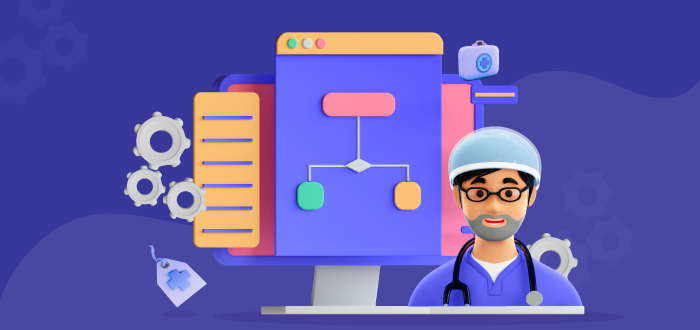


![What is Workflow Automation? [Examples and Software Checklist] 19 what is workflow automation](https://www.leadsquared.com/wp-content/uploads/2023/01/what-is-workflow-automation-80x80.jpg)
